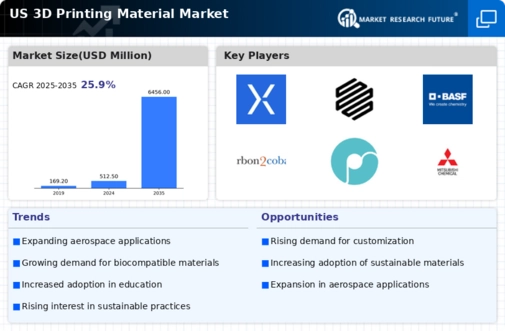The 3D printing-material market is currently characterized by a dynamic competitive landscape, driven by technological advancements and increasing demand across various sectors, including aerospace, automotive, and healthcare. Major players such as Stratasys (US), 3D Systems (US), and HP (US) are at the forefront, each adopting distinct strategies to enhance their market positioning. Stratasys (US) focuses on innovation through the development of advanced materials and software solutions, while 3D Systems (US) emphasizes strategic partnerships to expand its product offerings. HP (US) is leveraging its expertise in digital printing to penetrate the 3D materials market, indicating a trend towards cross-industry collaboration that shapes the competitive environment.
In terms of business tactics, companies are increasingly localizing manufacturing to reduce lead times and optimize supply chains. The market appears moderately fragmented, with a mix of established players and emerging startups. This structure allows for a diverse range of materials and technologies, fostering competition that drives innovation. The collective influence of key players is significant, as they invest in research and development to create high-performance materials that meet the evolving needs of various industries.
In October 2025, Stratasys (US) announced a partnership with a leading aerospace manufacturer to develop specialized materials for lightweight components. This collaboration is strategically important as it not only enhances Stratasys's product portfolio but also positions the company as a key player in the aerospace sector, which is increasingly adopting 3D printing technologies for production efficiency.
In September 2025, 3D Systems (US) launched a new line of bio-compatible materials aimed at the healthcare sector. This move is indicative of the company's commitment to innovation and addresses the growing demand for personalized medical solutions. By focusing on bioprinting applications, 3D Systems (US) is likely to capture a significant share of the healthcare market, which is rapidly evolving towards more customized treatments.
In August 2025, HP (US) unveiled a new 3D printing platform that integrates AI-driven analytics to optimize material usage and reduce waste. This initiative reflects a broader trend towards sustainability in the 3D printing-material market. By enhancing operational efficiency and minimizing environmental impact, HP (US) is positioning itself as a leader in sustainable practices, which is becoming increasingly important to consumers and businesses alike.
As of November 2025, current competitive trends are heavily influenced by digitalization, sustainability, and the integration of AI technologies. Strategic alliances are shaping the landscape, enabling companies to pool resources and expertise to drive innovation. The shift from price-based competition to a focus on technological advancement and supply chain reliability is evident. Moving forward, competitive differentiation will likely hinge on the ability to innovate and adapt to changing market demands, with a strong emphasis on developing sustainable and efficient solutions.























Leave a Comment